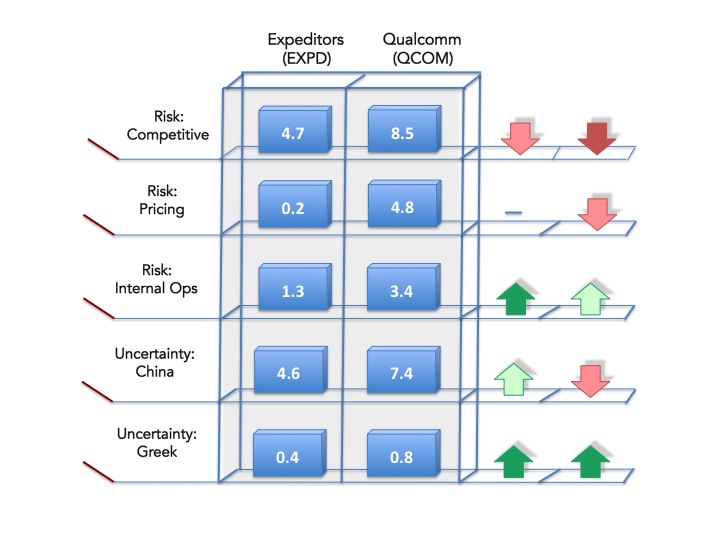In 1863 during the battle of Gettysburg, Union general Daniel Sickles decided to move his troops far in advance of the line demarcated by his superiors. As the troops moved out with flags flying and bands playing, another Union officer – Winfield Scott Hancock – watched the movement with great consternation. One of his staff officers commented that Sickles’ was disobeying orders. General Hancock looked through his binoculars, sighed, and said “they’ll come tumbling back soon enough.” And indeed they did. Hit with an enormous wave of Confederate soldiers, Sickles and his men suffered enormous losses almost causing the Union to lose the battle – if not the war.
The Overreaction Hypothesis
I bring this up because a stock on our watch list - SolarWinds (SWI) - had been roughly flat YTD until – in the words of Hancock – it came tumbling back losing 24.5% last Friday. In one day the company’s stock had gone from being roughly 10% undervalue to nearly 30% undervalue. A tumble indeed. Looking at the quarterly report and revised outlook we think the markets clearly overreacted to the call. We will get into the numbers in greater detail later in this article, but it would be helpful first to discuss why the market’s overreaction is important.
A seminal work on this topic was published by Werner De Bondt and Richard Thaler in 1985[1]. In their study, Bondt and Thaler placed the top performing 35 stocks over the past three (3) years into a portfolio entitled “Winners”. Correspondingly the worst performing 35 stocks were placed in a “Losers” portfolio. They then tracked each portfolio's performance against a representative market index for three years.
So what did they find? Interestingly the “Losers” portfolio beat the markets handily while the “Winners” portfolio underperformed significantly. The cumulative difference between the two portfolios was roughly 25% over the three-year period. A case of inversion if we’ve ever seen one.
The essence of their findings was that for every overreaction in a stock price there is an equal counter reaction. This works in both highly valued and low valued stocks alike. They described it as such:
“If stock prices systematically overshoot, then their reversal should be predictable from past return data alone, with no use of any accounting data such as earnings. Specifically, two hypotheses are suggested:
1. Extreme movements in stock prices will be followed by subsequent price movements in the opposite direction.
2. The more extreme the initial price movement, the greater will be the subsequent adjustment."
They went on to state there were three (3) core propositions that make up the actual amount of the overreaction. These include:
1. Directional Effect: Extreme movements in equity prices will be followed by movements in opposite direction.
2. Magnitude Effect: The more extreme the initial price change, the more extreme the offsetting reaction.
3. Intensity Effect: The shorter the duration of the initial price change, the more extreme the subsequent response.
SolarWinds: An Example
A case of the Overreaction Hypothesis is a stock that was on our watch list and now currently is a portfolio holding – SolarWinds (SWI). This is a company we would love to hold for the long term. Return on Equity of 21%, Return on Capital of 23%, no debt, $542M on the balance sheet, and conversion of 47% of revenue into free cash. Management has grown revenue at 21% annually since 2005 and free cash at 14% since 2010.
Last Thursday, management reported Q2 numbers. In addition to missing Q2 revenue estimates (while beating on EPS), the company guided for Q3 revenue of $130M-$134M (+15%-19% Y/Y, below a $136.1M consensus) and 2015 revenue of $502M-$512M (+17%-19% Y/Y, below a $519.7M consensus). EPS guidance was better: $0.49-$0.53 for Q3 (consensus is at $0.52) and $2.00-$2.08 for 2015 (consensus is at $2.00).
Anatomy of an Overreaction
These results provoked a collapse in the stock price – dropping to $35.54 or down 24.5% from its close of $47.05 on July 16th. We were surprised by the reaction of the markets. SWI reduced Q3 revenue guidance by 4.5% but is still projecting 15%-19% Y/Y growth. 2015 revenue estimates were reduced by 3.5% but still projecting 17%-19% Y/Y growth. Using a DCF model these changes reduced our estimated fair value from $54/share to $53/share or an estimated decrease of less than 2%. Friday’s loss would say that SWI is worth roughly 25% less today than it was last week. Followers of Efficient Market Theory (EMT) would tell us the price decrease represents the best information available and the true value of the company’s shares. We think this type of thinking is silly and a gross overreaction to Thursday’s earnings call.
Now that we’ve seen the massive downside movement, according to Bondt and Thaler we should see a short-term, significant upturn in price. That may be. But even if this doesn't work out, we have in our back pocket the ultimate asset for the value investor – an outstanding company selling at a significant discount to our estimated intrinsic value.
Conclusions
The Overreaction Hypothesis would tell us that for every market overreaction there is generally an overreaction in the opposite direction. Purchasing stocks that had such events on the negative side achieved significant outperformance versus those on the positive side. This makes sense as – generally - overreaction to the negative side can create opportunities at mispriced value. Those on the upside have generally stretched valuations. Whether SolarWinds is a successful example of the Overreaction Hypothesis will be tested over the next several months. Combined with its valuation, this is a transaction where we think the odds are in our favor over the long term.
[1] “Does the Stock Market Overreact?”, Werner F. M. De Bondt and Richard Thaler
The Journal of Finance, Vol. 40, No. 3, Papers and Proceedings of the Forty-Third Annual Meeting American Finance Association, Dallas, Texas, December 28-30, 1984 (Jul., 1985)


 RSS Feed
RSS Feed